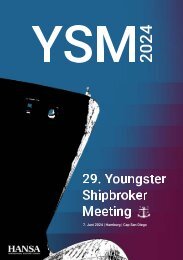HANSA 06-2019
Reparatur & Umbau | Start-Ups | COMPIT Review | CIMAC 2019 | Terminaltechnik | Batterien & Hybrid | Offshore-Flotte | U.A.E. | Cruise Ship Interiors | Zeaborn & Offen
Reparatur & Umbau | Start-Ups | COMPIT Review | CIMAC 2019 | Terminaltechnik | Batterien & Hybrid | Offshore-Flotte | U.A.E. | Cruise Ship Interiors | Zeaborn & Offen
Erfolgreiche ePaper selbst erstellen
Machen Sie aus Ihren PDF Publikationen ein blätterbares Flipbook mit unserer einzigartigen Google optimierten e-Paper Software.
Schiffstechnik | Ship Technology<br />
»Zero-emissions propulsion<br />
is tantalisingly close«<br />
Regulatory pressure is pushing large combustion<br />
engine makers to clean up their act. Paolo Tonon,<br />
Vice President Communication at the<br />
International Council on Combustion Engines<br />
(CIMAC), sees this as a challenge and<br />
incentive rather than a reason to worry<br />
© CIMAC<br />
CIMAC has recently been making a<br />
strong case for the Power-to-X concept<br />
and cross industry cooperation needed<br />
to make it become a reality. That’s the future<br />
– what’s moving the industry right<br />
now?<br />
Paolo Tonon: A great deal of discussion<br />
centres around the Sulphur Cap<br />
2020 and the overall effect of the shifting<br />
focus in engine emissions emphasis<br />
on Greenhouse Gases (GHG). As a result,<br />
the large engine industry is working<br />
simultaneously on the full spectrum<br />
of engine emissions. However, it must be<br />
said that because of the correlation between<br />
carbon dioxide (CO2) to fuel consumption,<br />
GHG reduction is essentially<br />
an increased focus on a perennial concern<br />
of every single engine developer and<br />
operator.<br />
What will be discussed at this year’s CI-<br />
MAC World Congress – besides Power-to-X<br />
and cross-sector cooperation?<br />
Tonon: CIMAC acted presciently when<br />
it founded the new working group System<br />
Integration. We think a lot of the discussion<br />
will centre around not only on<br />
the necessary interactions among systems<br />
onboard ships but among all the<br />
engine industry stakeholders: propulsion<br />
system builders, ship designers, and<br />
ship operators. Because one thing is certain<br />
– the CO2 targets set for 2050 will<br />
not be met by engine development alone.<br />
In the past, engines were singled out as<br />
the only source of emissions on a ship,<br />
even though inefficiencies elsewhere were<br />
also having a negative impact on emissions.<br />
Now the approach is a more holistic<br />
one, with other factors being considered,<br />
i.e. the overall efficiency of the system we<br />
call a ship.<br />
In a time of huge industry change,<br />
CIMAC aims to close the gap between<br />
ship-owners, ship-operators, and the<br />
shipping industry. This is reflected in an<br />
increased space given to end-users round<br />
tables.<br />
At the moment, zero emission operation<br />
still seems to be far away. What are the<br />
concrete measures and development areas<br />
right now?<br />
Tonon: There is still immense potential<br />
in the traditional areas of engine development<br />
– fuel injection, turbocharging and<br />
engine control. Fuel injection pressures<br />
which continue to rise is helping to increase<br />
engine efficiency of both two- and<br />
four-stroke engines as well as with the advancement<br />
of the two-stage turbocharging<br />
on four-stroke only beginning to be<br />
leveraged.<br />
In terms of control, electronics continue<br />
to become more sophisticated. The<br />
initial results of variable valve timing<br />
on large four-strokes engines are showing<br />
great potential in terms of improved<br />
overall control and making the engines<br />
far more flexible and economical.<br />
On the two-stroke side, there are innovative<br />
turbocharging and control systems,<br />
such as the first sequential turbochargers<br />
on two-strokes. New flexible exhaust<br />
valve timing and advanced turbochargers<br />
allow ships to switch from slow steaming<br />
to commercial cruising speeds easily and<br />
without any major modifications. This allows<br />
ship operators to closely match their<br />
power to their actual load profile.<br />
What could be effective short term solutions<br />
in the fight against green house<br />
gases?<br />
Tonon: A great hope for reducing both<br />
GHG and noxious emissions in the short<br />
term is gas- and dual-fuel engines. Since<br />
the last Congress two-stroke dual-fuel engines<br />
with both high- and low-pressure<br />
gas injection have proliferated while fourstroke<br />
dual-fuel engines are establishing<br />
themselves in all types of vessel, not only<br />
LNG carriers.<br />
This change is driven by IMO Tier III<br />
NO x limits and the Sulphur Cap 2020.<br />
52 <strong>HANSA</strong> International Maritime Journal <strong>06</strong> | <strong>2019</strong>


















